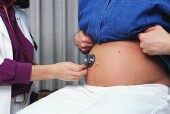
SATURDAY, Oct. 20 (HealthDay News) — Couples who undergo in vitro fertilization to try to have a baby are more likely to have an infant born with a birth defect, new research indicates.
It’s still unclear why, though, experts say.
“Our findings included a significant association between the use of assisted reproductive technology, such as certain types of in vitro fertilization, and an increased risk of birth defects,” said study author Dr. Lorraine Kelley-Quon, a general surgery resident at Ronald Reagan UCLA Medical Center, in Los Angeles, who conducted the research while at Mattel Children’s Hospital UCLA.
The findings were to be presented Saturday at the American Academy of Pediatrics annual meeting in New Orleans.
“Naturally conceived infants in the control arm of our study had a 6.6 percent baseline rate of major birth defects, while infants born after IVF had a 9 percent rate,” Kelley-Quon said.
The researchers analyzed hospital admission data for infants born in California between 2006 and 2007, along with vital statistics, the mother’s prenatal information and hospital records from the baby’s first year of life. They reported that nearly 3,500 infants were born with major congenital malformations out of a total of almost 51,000 infants — about 4,800 of whom were born after IVF.
Kelley-Quon noted that for the general population, there is a 3 percent rate of birth defects, such as a heart or vision problem. She and her colleagues expected their control group of naturally conceived infants to have a higher-than-average rate of birth defects than the general population because in this study every infant that had been conceived through IVF treatments was matched to 10 naturally conceived infants born to mothers with similar maternal and infant characteristics.
In other words, the researchers selected them to match their fertility-treatment-seeking group by race, mother’s age and race, and infant gender. Those seeking help getting pregnant tend to be older and white, for example.
“Our data confirmed this expectation,” she said.
The birth defects tracked included eye problems (0.3 percent in IVF infants vs. 0.2 percent in naturally conceived children), heart abnormalities (5 percent vs. 3 percent) and genital/urinary system problems (1.5 percent vs. 1 percent).
The scientists also performed a separate analysis on a group of infants born after non-IVF fertility treatments, including ovulation induction and artificial insemination, but they did not find a significant increased risk of birth defects in that analysis, Kelley-Quon said.
The risk of birth defects increased when the scientists performed their final analysis, comparing the fertility-treatment group to matched control infants.
“This translated to an odds ratio of 1.25, meaning there was a 25 percent increased risk of birth defects for infants born after IVF, compared to naturally conceived infants with similar baseline maternal and infant characteristics,” Kelley-Quon explained.
Many other studies have looked at IVF and birth defect risk, noted Dr. Edward Illions, of Montefiore’s Institute for Reproductive Medicine and Health, in New York City. Illions said he was not surprised by the results.
“We have outcomes since the early 1980s for IVF in this country,” he said. “The preponderance of studies certainly does suggest higher malformations in artificial reproductive technologies.”
Other countries have studied the issue as well, Illions said, noting a large May 2012 New England Journal of Medicine study by Australian researchers that looked at more than 300,000 births, of which 6,000 involved assisted reproductive technologies.
Illions said it’s too early to know why birth defects appear to be higher among couples that seek fertility treatments, and said it would have been helpful if the California study had tracked which couples received previous infertility treatments — that a history of IVF treatments could be related to birth defect rates.
But, he added, any number of other factors could be involved and need to be explored.
“The bottom line is we’re still not sure what component of the process is giving the risk,” he said. “Is it something we’re doing in the lab — the culture media, which contains a lot of synthetic growth factors and protein supplements? The fertility medications? Is it the nature of the illness itself — people with ovulatory dysfunction? Those are all potential confounding factors.”
The new research also raises questions about whether couples seeking IVF treatments should receive additional pre-conception counseling and whether the fetus should be monitored more closely if they are able to conceive.
“Nobody can assure a perfect baby,” said Dr. Joe Leigh Simpson, senior vice president for research and global programs at the March of Dimes, and president of the International Federation of Fertility Societies. He said couples considering IVF need to discuss the topic and their health histories thoroughly with their doctors.
“Couples need to be informed about the risks, but I don’t think it is going to change their desire to have children,” he said.
Struggling with infertility and seeking treatments can be emotionally and logistically challenging, and the study results should not cause more stress for couples, said Kelley-Quon.
“They should be reassured that there are tens of thousands of infants born each year after IVF who are perfectly healthy,” she said. “The purpose of our research was to highlight an interesting association between IVF and birth defects. Our results do not prove that IVF causes birth defects.”
While this study showed an association between IVF treatments and birth defects, it did not prove a cause-and-effect link. Research presented at medical meetings should be viewed as preliminary until published in a peer-reviewed journal.
More information
For more on IVF, go to the U.S. National Library of Medicine.

